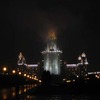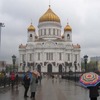Moscow's building boom leaves little room for history
MOSCOW -- Built in the late 1920s, the Narkomfin apartment building was designed as the perfect environment for new Soviet Man. A monument to the utopian communist ideals that spilled forth after the Bolshevik revolution, the six-story complex behind the US Embassy was a place where bourgeois decadence was expected to give way to collective existence.
Today this decaying, forgotten masterpiece of modernist architecture faces two possible futures: collapse, or conversion into a hotel.
As the construction industry in Russia's capital surfs a tide of petro-dollars, preservationists are warning the city's unique architectural heritage is under threat. Where the wrecking ball misses, neglect and botched restorations are doing equal damage. Since the breakup of the Soviet Union, an estimated 400 historic monuments, some dating to the 17th century, have been destroyed.
The boom in construction is fueled by an increasingly muscular Russian economy. High oil prices mean cash is pouring in to state coffers and wages are rising, prompting demand for new stores and housing. Shopping malls are mushrooming across the city, while new skyscrapers cast shadows over entire neighborhoods.
''In every other Russian city, it's the absence of money that is destroying historic buildings," said Aleksei Komech, director of the State Arts Research Institute. ''In Moscow, it's the abundance of it."
Critics say Moscow's city authorities are deeply enmeshed with building companies in a multibillion-dollar industry that has little regard for preservation. Since 1996, the area of new housing being constructed every year has increased by 60 percent, but a strong framework of laws to protect endangered monuments is frequently ignored because of corruption.
Historical groups such as the Moscow Architecture Preservation Society and Moskva, Kotoroy Net (''The Moscow That Is No More") say the trail of destruction leads to Mayor Yuri Luzhkov, who has expressed disdain for ''idiots for whom the preservation of old bricks is an aim in itself" and whose wife owns a construction business valued at more than $1 billion.
Earlier this month, architecture preservationists from across the world gathered in Moscow for the Heritage at Risk conference, calling on Luzhkov and President Vladimir Putin to stem the demolition.
Most threatened are avant-garde works from the early 20th-century such as the Narkomfin complex, famed architect Konstantin Melnikov's house-studio, and a series of workers' clubs. These buildings came from a brief flowering of vernacular architecture after the Bolsheviks' victory in the revolution and the civil war in the early 1920s, part of a wider movement to synchronize art with life.
''It was a time of incredibly bold ideas that were unique to Russia," said John Stubbs of the New York-based World Monuments Fund, who attended the heritage conference.
Architects were harnessed to create houses fit for a domestic utopia where families would live in harmony in communal dormitories, sharing all possessions. Nutritionists and child-care specialists would take care of chores while citizens were molded into a single, slick machine. Special rooms were even designated for sexual liaisons
The Narkomfin building was designed with such a lifestyle in mind. A ''semi-collectivized housing complex," it was constructed between 1928 and 1930 by the architect Moisei Ginzburg as a ''transitional" living space for employees of the Soviet Ministry of Finance.
Ginzburg stopped short of creating the full communal experience, but minimized kitchen areas and encouraged families to share facilities in a pavilion with a kindergarten (never finished), gymnasium, and canteen linked to the block of 56 apartments by a raised walkway.
Split-level apartments provided one common sleeping space per family and stoves were designed to reheat food prepared by specialists. Its early occupants complained of damp conditions and quickly tired of the communal existence, making alterations to their apartments and pleading for larger kitchens. But the building was viewed as a masterpiece.
Now, after years of neglect, Narkomfin's walls of compacted reed blocks are disintegrating, and the strips of horizontal windows on its once seamless facade are choked with weeds.
Luzhkov announced this month that an investor had been found to restore the building, but doubts remain that a commercial deal will ensure its survival.
On recent day, Valentin Survov ran a hand over the crumbling blocks that make up the walls of his home in the complex.
''Another few years and this place is going to fall apart," said Survov, 26, a disc jockey, who has lived in the building since childhood. ''Either that, or they'll tear it down."
He added, ''It's such a valuable place historically, it should really be turned into a museum."
The future of another avant-garde masterpiece also hangs in the balance. The Melnikov house-studio is a magical construction on a secluded lane in central Moscow. It was built by the celebrated architect Konstantin Melnikov in 1927 in the form of two interlocking cylinders studded with rhomboid windows.
Melnikov lived in the house -- one of the few private abodes allowed during the Soviet era -- with his family, and after his death it was left in the hands of his son, Viktor, a painter who was its faithful guardian all his life.
When Viktor Melnikov died in February at 91, his half-share in the house was donated to the state to create a museum. However, a private investor snapped up the other half from a relative, and what happens next is unclear.
Despite the criticism, some say the rash of new construction is not all doom and gloom. Last week, British architect Norman Foster made a visit to promote the nearly 2,000-foot tower that his partnership will build as part of Moscow City -- a huge development on the banks of the Moscow river, 3 miles from the Kremlin.
Lord Foster, a lifetime member of the House of Lords, was met with adulation by the art world glitterati as he opened an exhibition dedicated to his work at the Pushkin Fine Arts Museum.
He said he was unaware of any specific cases of historic buildings in the city being neglected or knocked down, adding: ''It's in the nature of any city that when it regenerates itself, it destroys old buildings to create new ones."
Asked whether he had qualms about being part of the construction boom, Lord Foster replied: ''If I look at the nature of the projects that we have here in Russia -- if that is fueled by the regeneration and the energy and the drive of Moscow and St. Petersburg, and you call that a boom and you ask me how I feel about being part of it, I'm really, really excited."
By Tom Parfitt, Globe Correspondent
 Podium
Podium





